Guggenheim Elementary School fights to save itself from closing...
ŌĆ£We are not a number!ŌĆØ That was the cry heard loud and clear from children, parents, and teachers in the wake of a barrage of graphs, numbers and data on display at a hearing Thursday, January 28, 2010, to prove why the Guggenheim Elementary School should not be closed. The Chicago Board of Education's numbers and chars supposedly prove that Guggenheim has "failed" and needs to be closed, its teachers and parents fired. The people of Guggenheim had a different version of the story: their children and their children's schools had not "failed." Human beings count more than graphs, charts, and Power Point presentations.
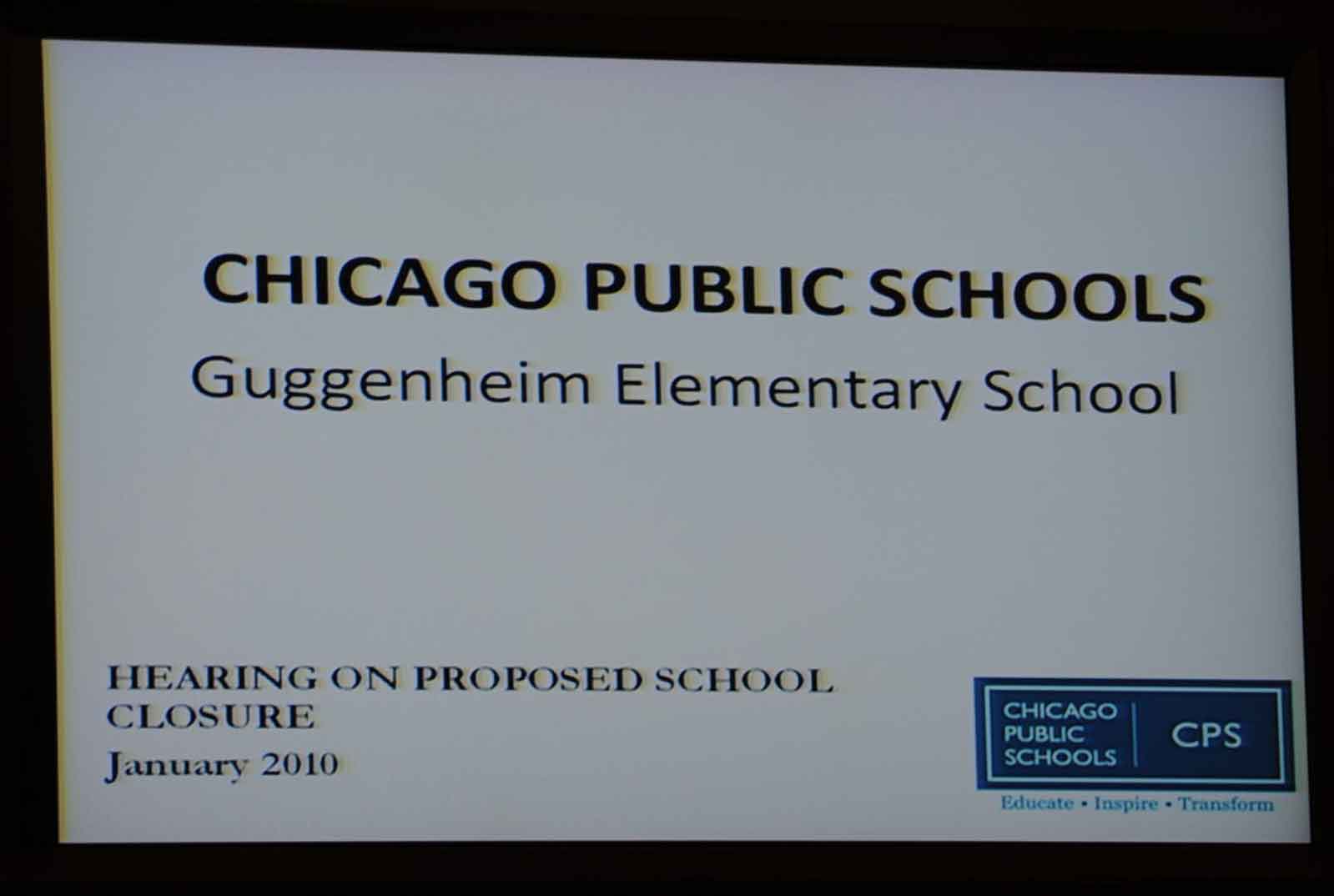 Above, first slide of the Board of Education's Power Point showing that Chicago's Guggenheim Elementary School has "failed." Substance photo.Board of Education officials presented Chicago SchoolŌĆÖs chief Ron HubermanŌĆÖs data assault of ISAT scores and attendance rates to shock and awe a packed crowd of 180 people (including at least 40 children) who attended the hearing in support of the public school located at 71st and Morgan. The hearing was being held because Chicago Schools Chief Executive Officer Ron Huberman has proposed that Guggeneim be closed for academic failure and its students dispersed among nearby schools, while its teachers are fired.
Above, first slide of the Board of Education's Power Point showing that Chicago's Guggenheim Elementary School has "failed." Substance photo.Board of Education officials presented Chicago SchoolŌĆÖs chief Ron HubermanŌĆÖs data assault of ISAT scores and attendance rates to shock and awe a packed crowd of 180 people (including at least 40 children) who attended the hearing in support of the public school located at 71st and Morgan. The hearing was being held because Chicago Schools Chief Executive Officer Ron Huberman has proposed that Guggeneim be closed for academic failure and its students dispersed among nearby schools, while its teachers are fired.
The Board began the hearing with three big guns ŌĆö including "Chief Administrative Officer Robert Runcie, the "Chief Area Officer, the "Director of Accountability", and the "Deputy Director of Security" ŌĆö to make their case why Guggenheim should be closed. A series of Power Point presentations and graphs going up and down and every which way were on display.
Although Huberman claims his ŌĆ£performance management policyŌĆØ does not focus exclusively on test scores and attendance, those were the two primary factors presented at the Guggenheim closing hearing to prove that Guggenheim has "failed."
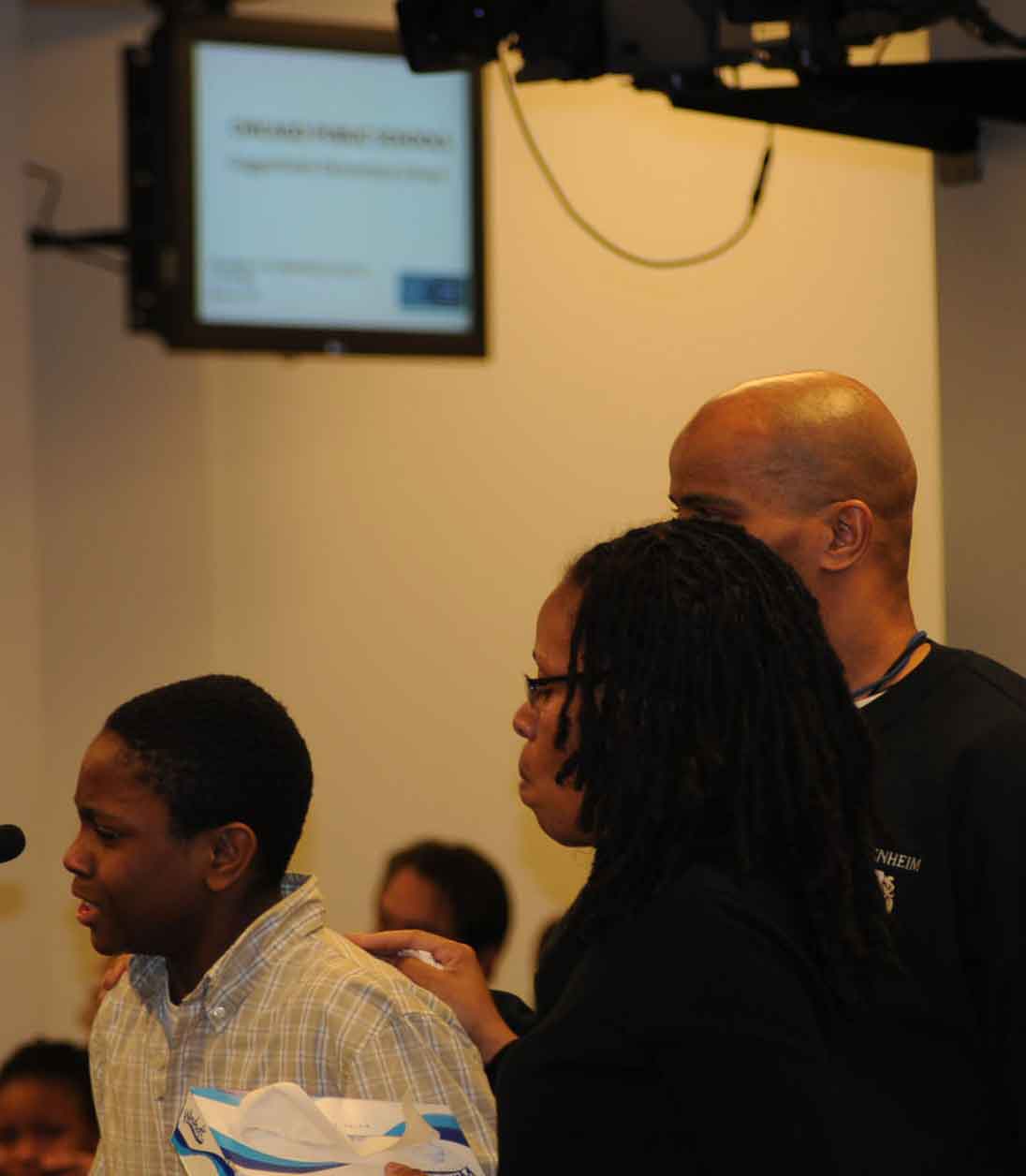 A student who had tried to speak in defense of Guggenheim Elementary School (identified only by a number on orders of hearing officer Fred Bates) broke down crying during his description of how Guggenheim had changed his life for the better. Two teachers had to come forward to comfort him. Hearing Officer Fred Bates annoyed parents, teachers and other observers by constantly interrupting the testimony to remind the hearing that he had been raised in Englewood, as if that made what he was doing (and has been doing for 15 years thanks to his clout with Mayor Daley) somehow acceptable to those whose schools were being destroyed. Bates began his career as a CPS hearing officer with the first "Resconstitution" hearing against Englewood High School on June 18, 1997. Englewood was "reconstituted" following Bates's recommendation in 1997, and nothing changed. Englewood was reconstituted again and again, at times with Bates again serving as the Board's hired hearing officer. Substance photo by George N. Schmidt. But Guggenheim did not back down. Instead they fired right back ŌĆō in an opening battle of a war to close 14 neighborhood schools that will continue to be waged in the next few weeks before the Board of Education votes at the next Feb. 24 public meeting.
A student who had tried to speak in defense of Guggenheim Elementary School (identified only by a number on orders of hearing officer Fred Bates) broke down crying during his description of how Guggenheim had changed his life for the better. Two teachers had to come forward to comfort him. Hearing Officer Fred Bates annoyed parents, teachers and other observers by constantly interrupting the testimony to remind the hearing that he had been raised in Englewood, as if that made what he was doing (and has been doing for 15 years thanks to his clout with Mayor Daley) somehow acceptable to those whose schools were being destroyed. Bates began his career as a CPS hearing officer with the first "Resconstitution" hearing against Englewood High School on June 18, 1997. Englewood was "reconstituted" following Bates's recommendation in 1997, and nothing changed. Englewood was reconstituted again and again, at times with Bates again serving as the Board's hired hearing officer. Substance photo by George N. Schmidt. But Guggenheim did not back down. Instead they fired right back ŌĆō in an opening battle of a war to close 14 neighborhood schools that will continue to be waged in the next few weeks before the Board of Education votes at the next Feb. 24 public meeting.
Last year 22 schools were slated to close ŌĆö but six were taken off the list after massive public protests. At every hearing, dozens of people showed up to challenge the list, which was compiled by Arne Duncan before he left for Washington, D.C. It was implemented by Ron Huberman, who was appointed by Mayor Daley to follow Duncan as "Chief Executive Officer" at Chicago's public schools. Huberman's previous career had been in buses and subways as President of the Chicago Transit Authority.
ŌĆ£When you hear all this data and numbers, just remember youŌĆÖre not a number,ŌĆØ Chicago Teachers Union President Marilyn Stewart said as she turned to the crowd made up of many children who came to testify and save their school.
Guggenheim Principal Mary McNair seconded Stewart.
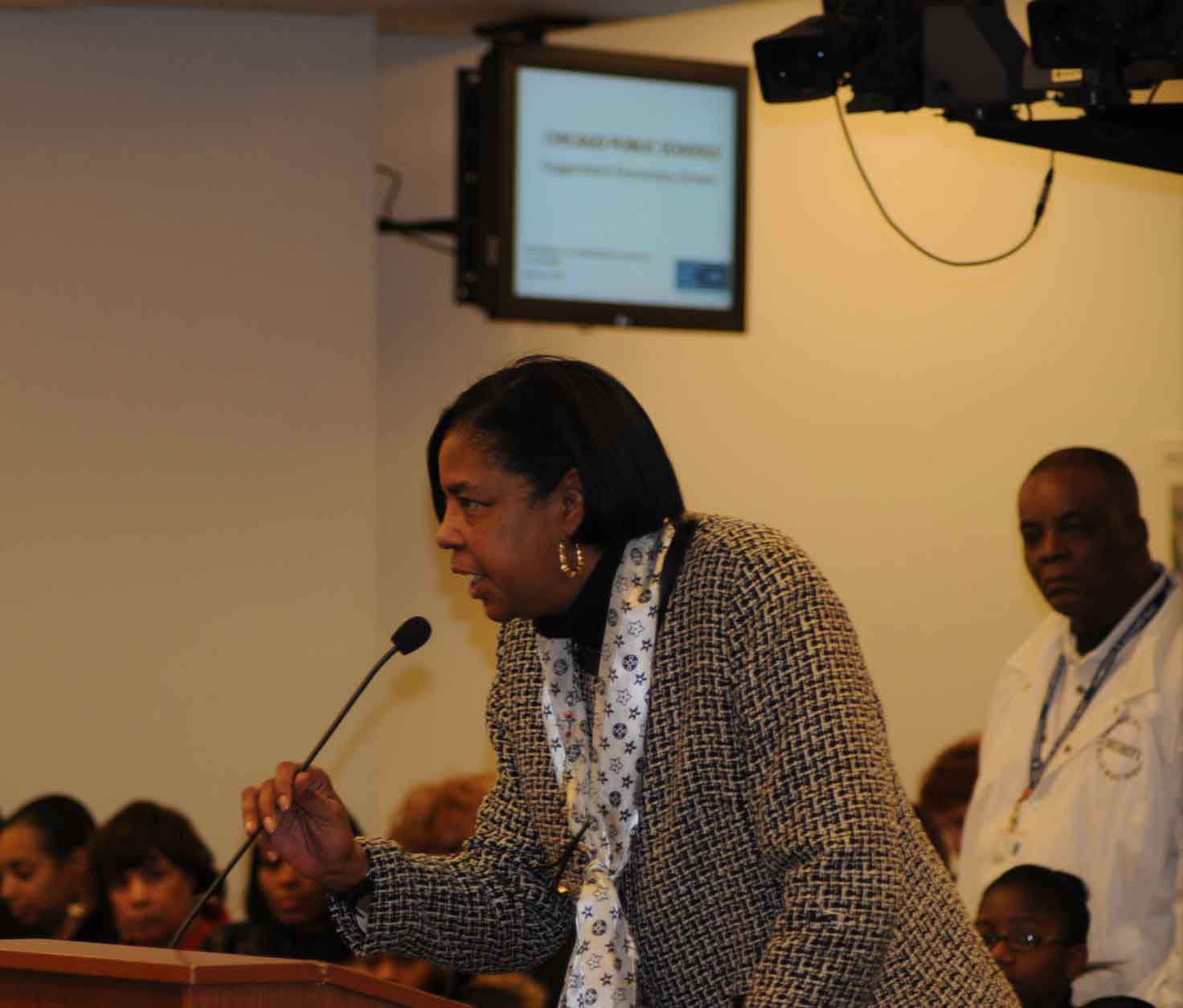 Guggenheim Principal Mary McNair spoke forcefully against the attempt by CPS administrators and lawyers to reduce the complexity of Guggenheim and its history to a Rube Goldberg contraption called "Performance Management." Although hearing office Fred Bates terminated the hearing before every speaker was allowed to speak, the hearing was unanimous in opposing the closing of Guggenheim and refuting every pretext presented by CPS officials. Substance photo by George N. Schmidt.ŌĆ£I came here her to talk about the things you donŌĆÖt know. The numbers donŌĆÖt know the school,ŌĆØ McNair said. She went on to list all the wonderful things the Guggenheim school is proud of: after school programs, literacy and math programs, wonderful teachers who come early and stay late, and partnerships with the community.
Guggenheim Principal Mary McNair spoke forcefully against the attempt by CPS administrators and lawyers to reduce the complexity of Guggenheim and its history to a Rube Goldberg contraption called "Performance Management." Although hearing office Fred Bates terminated the hearing before every speaker was allowed to speak, the hearing was unanimous in opposing the closing of Guggenheim and refuting every pretext presented by CPS officials. Substance photo by George N. Schmidt.ŌĆ£I came here her to talk about the things you donŌĆÖt know. The numbers donŌĆÖt know the school,ŌĆØ McNair said. She went on to list all the wonderful things the Guggenheim school is proud of: after school programs, literacy and math programs, wonderful teachers who come early and stay late, and partnerships with the community.
The schoolŌĆÖs social worker said there are over 200 Guggenheim alums who keep in touch with the school that had an impact on their lives, many of whom have gone on to college and excelled. Another former teacher noted there are three National Board Certified Teachers among the current staff.
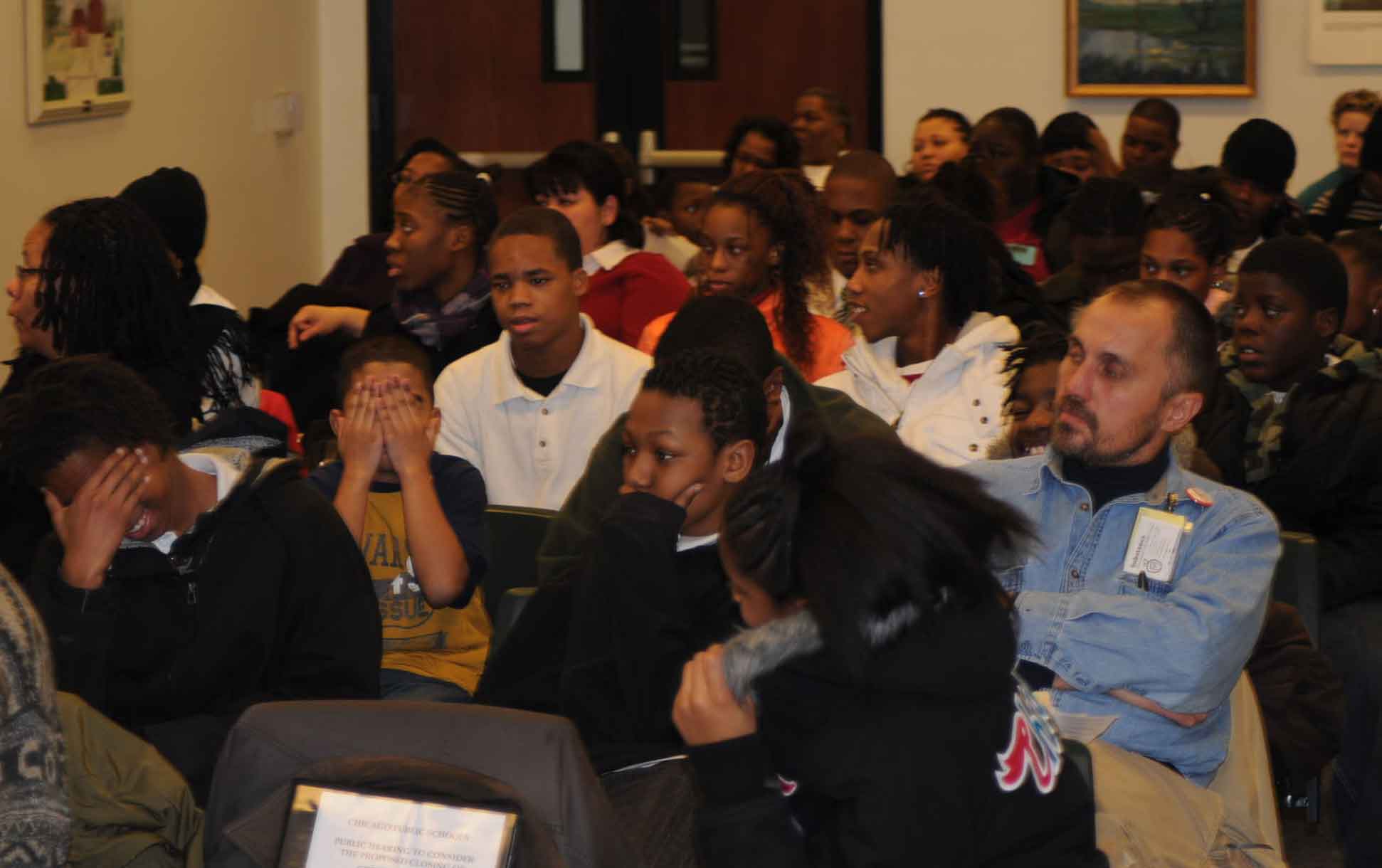 More than 180 people stayed at the Board of Education until 10:00 p.m. on January 29, 2010, for the hearing on the proposal to close Guggenheim Elementary School. Approximately 40 of those were children, some of whom testified despite the hearing officer's claim that state law didn't allow children to testify unless they had parental permission (all of the children had permission to be on the bus and at the hearing, but that was ignored). Seated on the right is Substance reporter and displaced teacher John Kugler, who also testtifed at the hearing. Substance photo by George N. Schmidt.ŌĆ£Our children are more than numbers,ŌĆØ said Shirley King, a former staff member and parent of Guggenheim students. ŌĆ£ItŌĆÖs more than just academics. ItŌĆÖs also social. They know itŌĆÖs a safe school. I donŌĆÖt see how transferring these kids to other schools with their problems will solve the problem.ŌĆØ
More than 180 people stayed at the Board of Education until 10:00 p.m. on January 29, 2010, for the hearing on the proposal to close Guggenheim Elementary School. Approximately 40 of those were children, some of whom testified despite the hearing officer's claim that state law didn't allow children to testify unless they had parental permission (all of the children had permission to be on the bus and at the hearing, but that was ignored). Seated on the right is Substance reporter and displaced teacher John Kugler, who also testtifed at the hearing. Substance photo by George N. Schmidt.ŌĆ£Our children are more than numbers,ŌĆØ said Shirley King, a former staff member and parent of Guggenheim students. ŌĆ£ItŌĆÖs more than just academics. ItŌĆÖs also social. They know itŌĆÖs a safe school. I donŌĆÖt see how transferring these kids to other schools with their problems will solve the problem.ŌĆØ
The highlight of the evening was eighth grader Robert Campbell ŌĆö who spoke like a little Martin Luther King ŌĆö his voice calm in the beginning, yet rising in intensity and emotion, until he had to eventually be carried from the podium, tears streaming down his face and his little body shaking after a speech that rocked the Board chambers.
ŌĆ£Sir, Guggenheim is a family,ŌĆØ Campbell said. ŌĆ£And when you separate us which you are trying to do, you are breaking up this family. It is like a divorce. And we will not allow our family to be separated.ŌĆØ
Known as ŌĆ£Little Macolm,ŌĆØ Campbell spoke the following day at a Rainbow Push event in which he literally brought the crowd to its feet cheering madly as he bellowed out why saving their school is the civil rights issue of today. Jesse Jackson, Jr., the former U.S. presidential candidate and the countryŌĆÖs leading African-American civil rights leader who heads Rainbow Push, commented later that this boy is a future star.
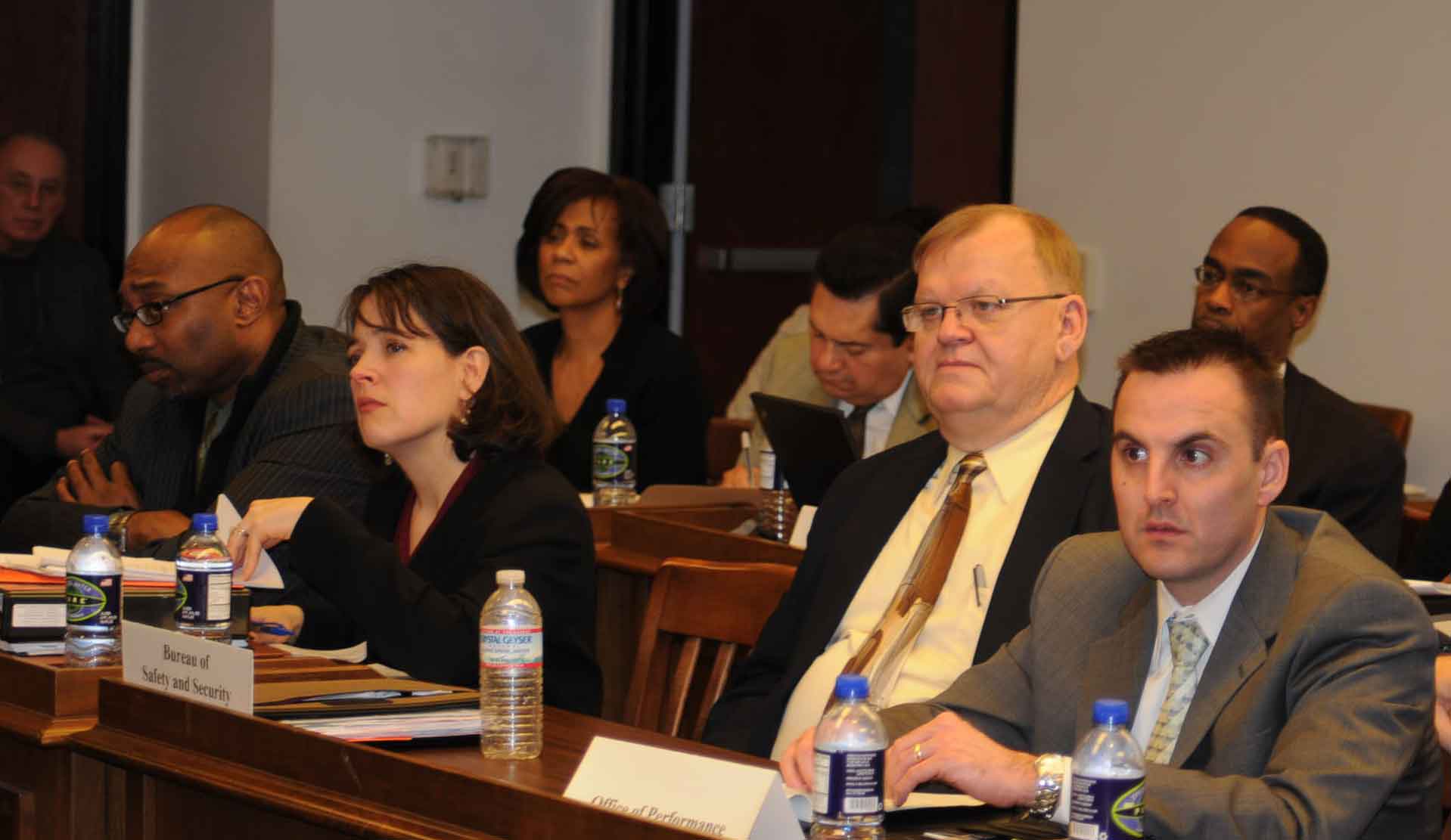 Members of the Chicago Board of Education (back row, left) are finally attending the hearings, despite the fact that they have voted for eight years to rubber stamp every school closing demanded by Mayor Daley (who appointed them) and recommended by the "CEO" (first Arne Duncan; now Ron Huberman). The "case" presented by the Board for closing schools such as Guggenheim is brought in front of the hearing officer by CPS executives, most of whom have no classroom experience, such as those above. Left to right, front row, Area 14 'Chief Area Officer' Adrian Willis, CPS attorney O'Keefe, CPS 'Deputy Director of Security and Safety' Stephen Glombicki, CPS 'Director of Performance Management' Ryan Crosby. Back row: Peggy Davis, Chief Officer for Diversity, Exelon Corporation (Board of Education member); Alberto Carrero, retired President, Banquo Popular (Board of Education member); and Robert Runcie, 'Chief Administrative Officer', Chicago Public Schools. The only person in the above photograph who ever spent a full year teaching in a Chicago classroom is Willis. The majority of the rest were not holding their current positions one year ago. Substance photo by George N. Schmidt. The students in all ages and forms, continued to speak ŌĆō either from the heart or a script, about why their school should not be closed. Another eighth grade student used the word obstreperous, which turned the heads of many, including the hearing officer who asked how long he had been attending the south side school.
Members of the Chicago Board of Education (back row, left) are finally attending the hearings, despite the fact that they have voted for eight years to rubber stamp every school closing demanded by Mayor Daley (who appointed them) and recommended by the "CEO" (first Arne Duncan; now Ron Huberman). The "case" presented by the Board for closing schools such as Guggenheim is brought in front of the hearing officer by CPS executives, most of whom have no classroom experience, such as those above. Left to right, front row, Area 14 'Chief Area Officer' Adrian Willis, CPS attorney O'Keefe, CPS 'Deputy Director of Security and Safety' Stephen Glombicki, CPS 'Director of Performance Management' Ryan Crosby. Back row: Peggy Davis, Chief Officer for Diversity, Exelon Corporation (Board of Education member); Alberto Carrero, retired President, Banquo Popular (Board of Education member); and Robert Runcie, 'Chief Administrative Officer', Chicago Public Schools. The only person in the above photograph who ever spent a full year teaching in a Chicago classroom is Willis. The majority of the rest were not holding their current positions one year ago. Substance photo by George N. Schmidt. The students in all ages and forms, continued to speak ŌĆō either from the heart or a script, about why their school should not be closed. Another eighth grade student used the word obstreperous, which turned the heads of many, including the hearing officer who asked how long he had been attending the south side school.
Alton Hooker, who attended the school as well as his children, said itŌĆÖs a magnificent school and a family, ŌĆ£definitely not a number.ŌĆØ Another parent who moved outside the district, said she brought her kids back because itŌĆÖs such a great school.
Many parents voiced concerns that it will be unsafe for the children to have to walk more than 6 blocks to the other receiving schools. The Board presented a security plan in the beginning of the meeting to address this issue, but the parents didnŌĆÖt seem convinced.
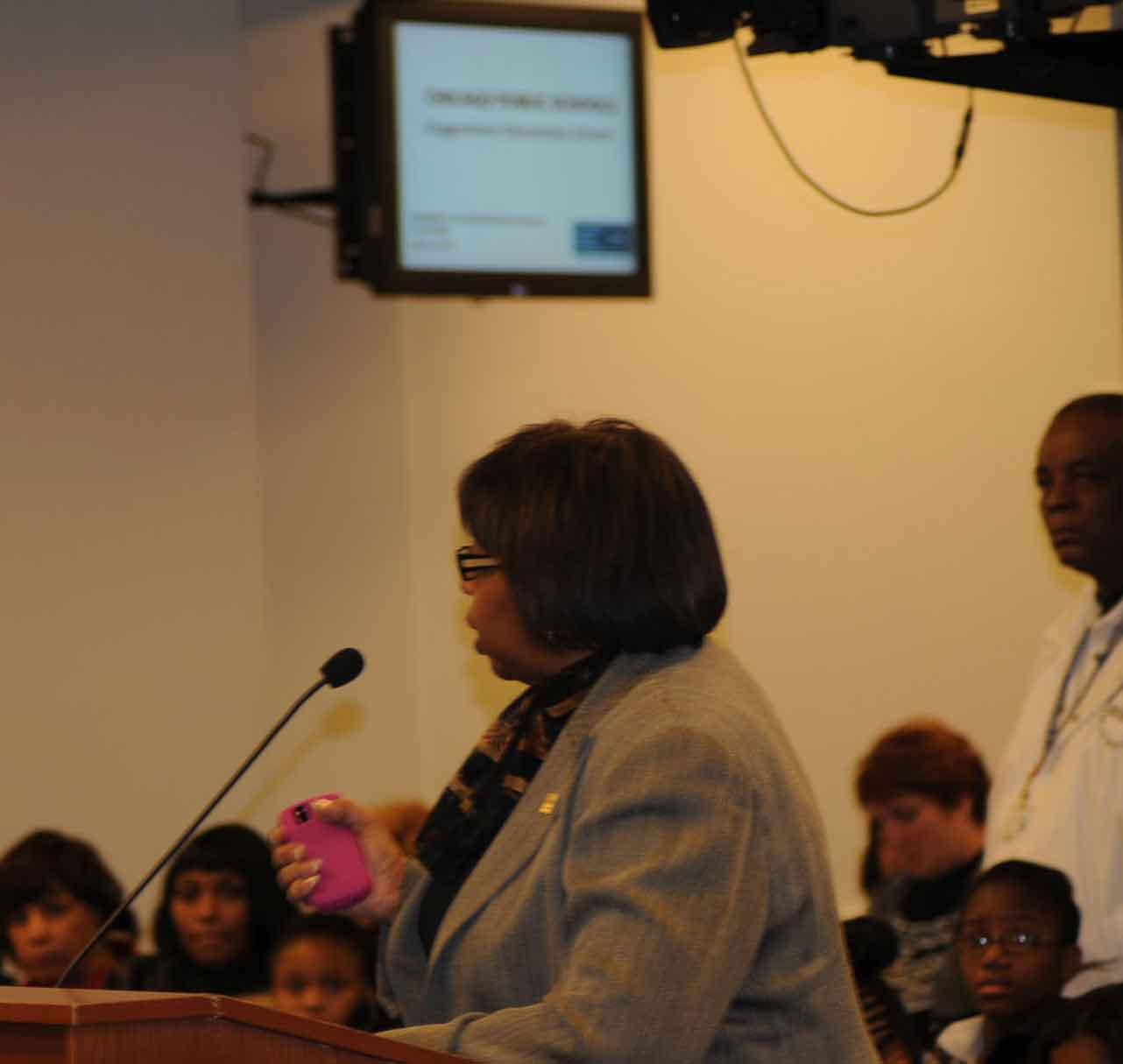 Chicago Teachers Union President Marilyn Stewart (above) reminded the hearing officer and the "board" behind the railing that the children and teachers of Guggenheim were human beings, not data points on a "Performance Management" matrix. Substance photo by George N. Schmidt.One set of data that the Board chastised Guggenheim for was the slight dip in the attendance rate from 91% to 89%, making it sound like this was a sin unforgivable. But Guggenheim assistant principal Gervaise Clay explained that when one child is sick, the parents will keep their siblings home as well. It should have also been noted that while the Board wants to hold schools accountable for the attendance rate, the Board used to employ truancy officers whose specific jobs were to make sure kids attended class. According to another teacher, one of the Learn charter schools had a much lower 75% attendance rate, yet no reprimand from the Board.
Chicago Teachers Union President Marilyn Stewart (above) reminded the hearing officer and the "board" behind the railing that the children and teachers of Guggenheim were human beings, not data points on a "Performance Management" matrix. Substance photo by George N. Schmidt.One set of data that the Board chastised Guggenheim for was the slight dip in the attendance rate from 91% to 89%, making it sound like this was a sin unforgivable. But Guggenheim assistant principal Gervaise Clay explained that when one child is sick, the parents will keep their siblings home as well. It should have also been noted that while the Board wants to hold schools accountable for the attendance rate, the Board used to employ truancy officers whose specific jobs were to make sure kids attended class. According to another teacher, one of the Learn charter schools had a much lower 75% attendance rate, yet no reprimand from the Board.
Although no local politicians came out to support the neighborhood school ŌĆō Jesse Jackson JrŌĆÖs son Jonathan Jackson ended the night chastising everyone from Chicago Mayor Richard Daley to the Board of Education members ŌĆō there were two Alberto Carerro and Peggy Davis in attendance ŌĆō for the Renaissance Plan that is closing public schools at a rapid pace.
ŌĆ£I came here as a concerned citizen and friend of Guggenheim,ŌĆØ Jackson said. ŌĆ£What these numbers donŌĆÖt show are the children. A school cannot fail. Sure there are some numbers that need to come up, but the Board members have to come down and visit this school.ŌĆØ
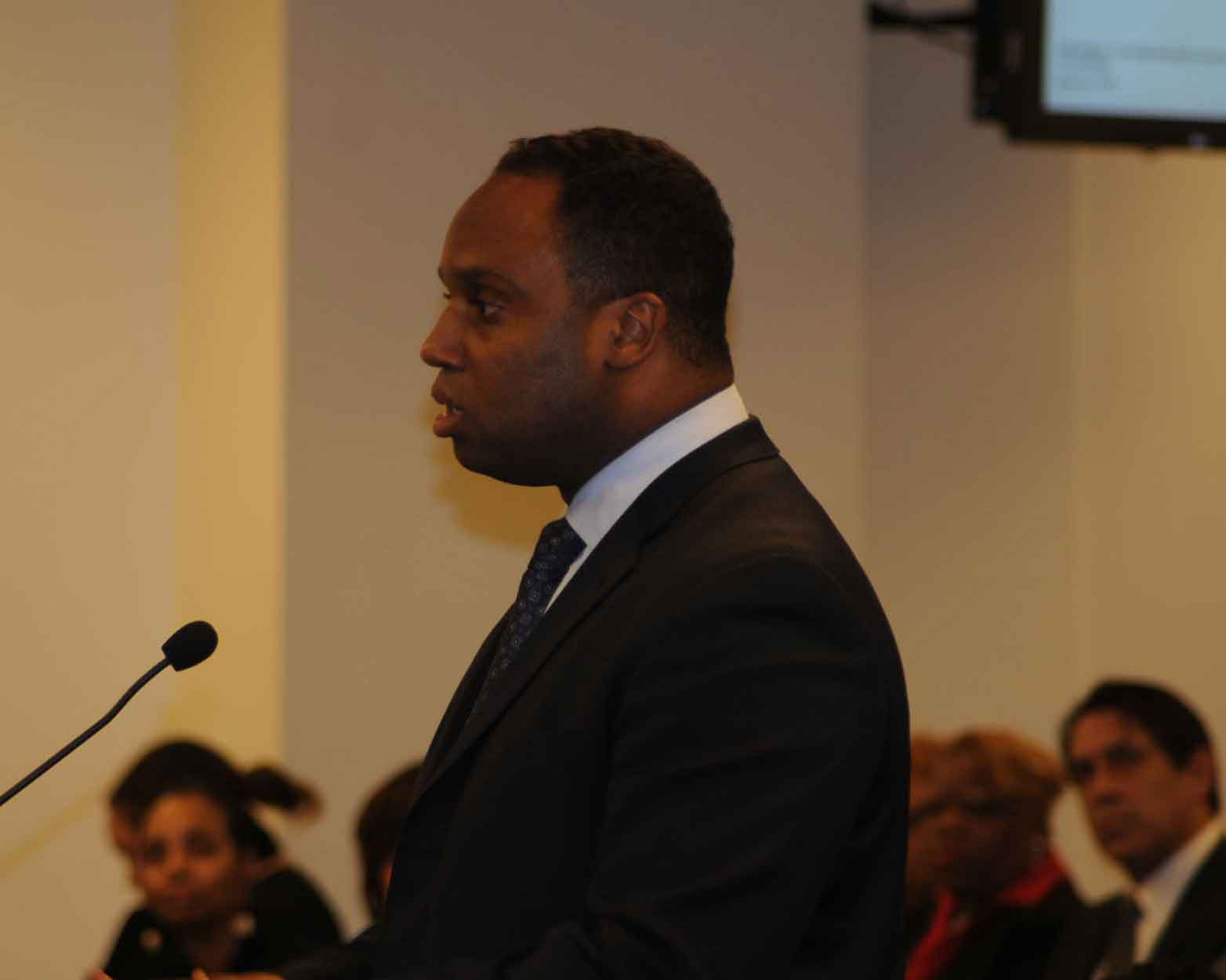 One of the many community leaders who denounced the Board's latest attack on Black schools and educators in Chicago's African American community was Jonathan Jackson (above, speaking at the Guggenheim hearing). Jackson, who works at Operation PUSH and is the son of Rev. Jesse Jackson Sr., has dedicated himself to blocking further closings of schools in Black Chicago. Last year, he helped stop the attack on Holmes school. This year, he has promised more activism. Jackson has begun noting that more than 95 percent of the schools closed by Arne Duncan and Ron Huberman have been all-black, and that the majority of the teachers and principals whose careers have been slandered then destroyed by the closing policies of Duncan and Huberman have been black leaders in their communities. Last year, Rev. Jesse Jackson noted for the first time that the destruction of these schools is destroying the "institutional memory" of Black Chicago, once called "The Black Metropolis." Many observers now agree that the destruction of Black leadership through the destruction of Black schools is a priority of the administration of Mayor Richard M. Daley. Substance photo by George N. Schmidt.Jackson called it ŌĆ£drive by counselingŌĆØ in response to what Chief Area Officer Adriane Willis had said about providing a team of literacy coaches who tried to help the school. A Guggenheim teacher noted at the hearing that the reading specialist position was actually cut.
One of the many community leaders who denounced the Board's latest attack on Black schools and educators in Chicago's African American community was Jonathan Jackson (above, speaking at the Guggenheim hearing). Jackson, who works at Operation PUSH and is the son of Rev. Jesse Jackson Sr., has dedicated himself to blocking further closings of schools in Black Chicago. Last year, he helped stop the attack on Holmes school. This year, he has promised more activism. Jackson has begun noting that more than 95 percent of the schools closed by Arne Duncan and Ron Huberman have been all-black, and that the majority of the teachers and principals whose careers have been slandered then destroyed by the closing policies of Duncan and Huberman have been black leaders in their communities. Last year, Rev. Jesse Jackson noted for the first time that the destruction of these schools is destroying the "institutional memory" of Black Chicago, once called "The Black Metropolis." Many observers now agree that the destruction of Black leadership through the destruction of Black schools is a priority of the administration of Mayor Richard M. Daley. Substance photo by George N. Schmidt.Jackson called it ŌĆ£drive by counselingŌĆØ in response to what Chief Area Officer Adriane Willis had said about providing a team of literacy coaches who tried to help the school. A Guggenheim teacher noted at the hearing that the reading specialist position was actually cut.
When asked if he would visit the school after hearing the testimony at the hearing, Board member Carerro told Substance his only real concern is communication - why didnŌĆÖt this school know that it was on probation for three years. ’Ż┐
Comments:
By: Deborah Anne Stewart
Teacher/Librarian/Doctoral Student
"God forgive them."
The Chicago Board of Education keeps pretending that it does not know the social, psychological, emotional, and academic damage it does to students by closing schools. Some children have been closed out of three schools. What kind of mental damage does that do to a child? Let us pray for change; let us pray for the hearts and minds of the children.


By: chitownteacher
Why Parents Fight to Keep "Failing" Schools Open
Here's a great story by Lutton on City RoomŌäó - Education - Why Parents Fight to Keep ŌĆ£Failing" Schools Open at http://www.wbez.org/Content.aspx?audioID=39606. This gets at the heart of the matter. A perspective rarely heard in Chicago media.
Jan 31, 2010 ... WBEZ visited Chicago's Guggenheim Elementary, one school on the closure list, to find out why ...
Don't miss this one.